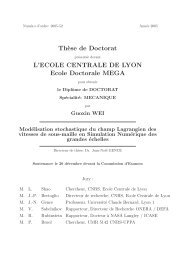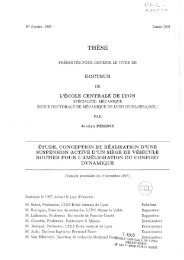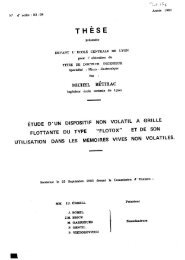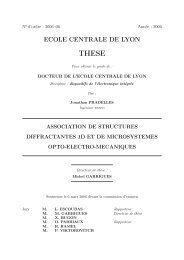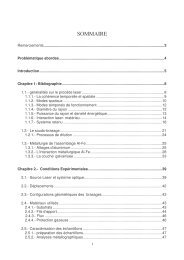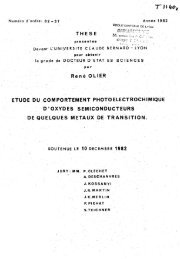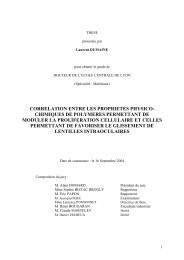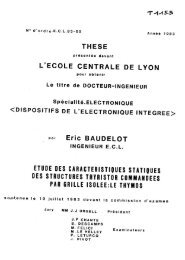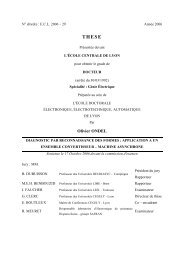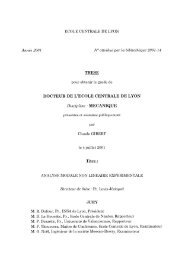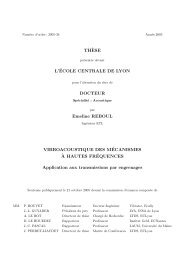Développement de capteurs à fibre optique basés sur la résonance ...
Développement de capteurs à fibre optique basés sur la résonance ...
Développement de capteurs à fibre optique basés sur la résonance ...
Create successful ePaper yourself
Turn your PDF publications into a flip-book with our unique Google optimized e-Paper software.
Article 2 Accepted by Sensor & Actuator A ( on 5 Nov., 1999, Reg. No. 99433 )<br />
multi<strong>la</strong>yered p<strong>la</strong>nar structure. Both of the reflectivity to the p- and s- po<strong>la</strong>rized electric field<br />
components in this configuration can be calcu<strong>la</strong>ted by matrix method[l 1].<br />
The programs written in Mat<strong>la</strong>b have been <strong>de</strong>veloped. The computed results for the<br />
mea<strong>sur</strong>ed fiber are illustrated in figure 6 by utilizing the parameters: the dielectric constant of<br />
55nm gold film is -13.8+i 1.8 at wavelength of 670nm, the refractive in<strong>de</strong>x of core and<br />
c<strong>la</strong>dding are 1.457 and l.407+i 54406x11115 respectively at the room temperature. The<br />
imaginary part of the in<strong>de</strong>x of the c<strong>la</strong>dding is previously <strong>de</strong>termined by the least-square fit of<br />
the experimental curve mea<strong>sur</strong>ed in air for the same fiber prior to the <strong>de</strong>position of gold <strong>la</strong>yer.<br />
The computational curves agree well with the experimental ones (cf. figure 3).<br />
4. Analysis of the fiber-optic sensor<br />
4.1 Sensitivity<br />
This kind of fiber-optic sensor usually works with a fixed inci<strong>de</strong>nt angle to monitor the<br />
variation of the <strong>de</strong>tected parameter such as the refractive in<strong>de</strong>x of the bulk medium by<br />
mea<strong>sur</strong>ing the change of the transmitted light power. Figure 7 illustrated both the theoretical<br />
and experimental responses of the mea<strong>sur</strong>ed fiber in p- and s- po<strong>la</strong>rized illumination at some<br />
fixed inci<strong>de</strong>nt angles of 8°, 12° 16° and 200 respectively. The good agreements between the<br />
computations and the experiments prove the validity of this 3D mo<strong>de</strong>l.<br />
The sensitivity of the sensor in monitoring the refractive indices of the bulk media is<br />
<strong>de</strong>fined as the <strong>de</strong>rivative of the normalized light power transmitted with respect to refractive<br />
in<strong>de</strong>x. Correspondingly, the curves of sensitivity for p- and s- po<strong>la</strong>rization of inci<strong>de</strong>nt light<br />
respectively are calcu<strong>la</strong>ted and plotted in figure 8. They <strong>de</strong>monstrate that the p-po<strong>la</strong>rization<br />
illumination has higher sensitivity than s-po<strong>la</strong>rization. It is evi<strong>de</strong>nt because only p-po<strong>la</strong>rized<br />
component of the electric-field serves to the SFR sensing. However, the sensitivity between<br />
p- and s- po<strong>la</strong>rization illuminations becomes hard to be distinguished as the SPR sensing part<br />
is far away from the input end of the fiber. An example is given in figure 9 fòr ii, the distance<br />
from the input end o[the fiber to the SFR sensing part, is equal to 80mm, as other parameters<br />
in these calcu<strong>la</strong>tions are kept constant.<br />
33



